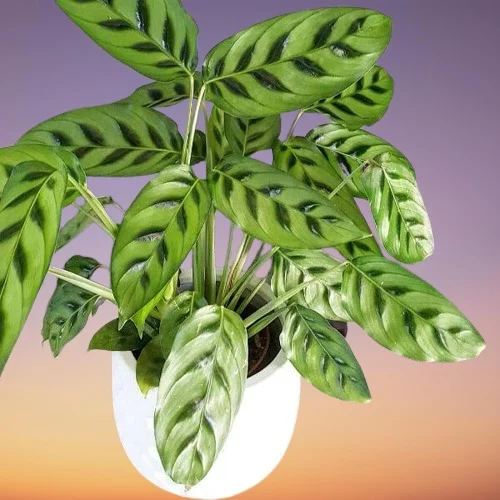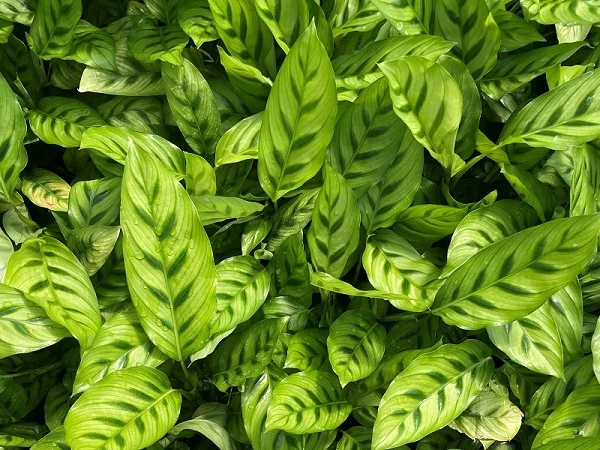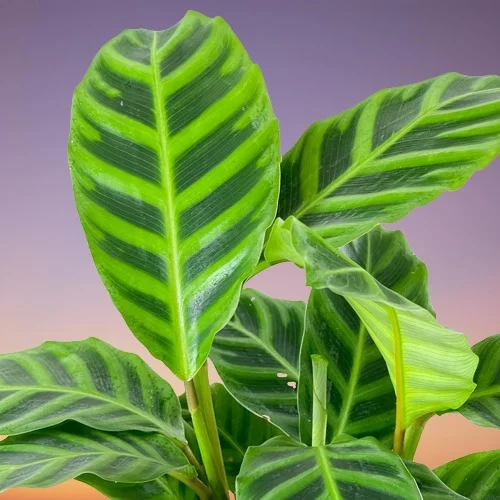Calathea leopardina (Calathea Freddie) Indoor Care, Propagation, Problems & Solutions
Some links in this post may be affiliate links
Calathea leopardina (Calathea Freddie) blossoms in bright indirect light, warm and humid conditions and consistently moist, rich, well-drained soil coupled with monthly feeding in the growing season.
This guide will cover how to care for Calathea leopardina indoors, including propagation methods and troubleshooting common plant problems. Let's delve into some facts about this plant.
Calathea Freddie is one of the popular Calathea varieties and bears long, light-green leaves with darker green zebra stripes and purple undersides which grow almost horizontally and are held up by long stems which makes it easy to admire them as they grow.

Botanical name: Calathea leopardina
Synonym: Goeppertia concinna
Family: Marantaceae
Common name: Calathea Freddie
Origin
Calathea leopardina also called Goeppertia concinna is native to the tropical forests in southeast region of Brazil where it grows as an understory plant.
Size and Flower
Calathea Freddie grows in clumps to a height of about 2-3 feet. The plant is not grown for the flower but for the pretty foliage and is unlikely to flower under room conditions.
Is Calathea leopardina toxic?
Calathea leopardina like other Calathea Plants is non-toxic to humans and pets as outlined by ASPCA. Calathea Freddie is safe for cats, dogs and other pets. It safe to grow in a home with children and pets.
Related Plants
Calathea leopardina is related to the Marantas, Ctenanthe and Stromanthe which are collectively called Prayer Plants in reference to their curious characteristic of closing their leaves at night.
Where to Buy
If you would like to add Calathea Freddie to your collection, you may obtain them online from Etsy (Link to Etsy).
How do you care for Calathea Freddie indoors?
Caring for Calathea Freddie entails providing bright indirect light, average warmth of 15-260C, high humidity of 60-80% and consistently moist, rich, well-drained soil coupled with monthly feeding during the growing season.
Good Calathea leopardina care requires pruning to keep it neat and also reduce pest and disease infestations. Repotting is needed only when the plant becomes pot-bound. Keep reading for more on the best growing conditions and how to provide them.

Watering
How often should I water Calathea Freddie?
Do not water Calathea Freddie on a schedule to avoid overwatering or underwatering.
Water your Calathea Freddie when the top 1-2 inches of soil dry to keep the soil consistently moist in spring and summer. Avoid overwatering as it can lead to yellowing and rotting.
Reduce watering in the cold season (fall and winter) as growth is minimal at this time. However, do not allow the soil to dry out completely to avoid drooping and curling, crispy leaf edges.
Use water that is at room temperature to avoid shocking this tropical plant which can result in reduced growth. The water should also be free of chlorine and flourides to avoid brown leaf tips and edges.
Make sure that the pot has a drainage hole and the soil is well-draining to avoid getting soggy soil as it can lead to root-rot and eventual death of the plant.
To minimize fungal infestations like leaf spot diseases, avoid wetting the foliage during watering or water from the bottom instead.
Light Requirements
Where should I put my Calathea Freddie?
Calathea Freddie thrives in bright indirect light. Put it a few feet from a large well-lit window. Keep it away from direct sunlight to avoid scorching and loss of leaf color.
If the lighting is not sufficient, it may lead to slow growth and less vibrant leaves. Therefore, move the plant to a brighter spot or use grow lights to ensure the plant receives the right amount of light.
For even growth to prevent lopsided growth, regularly rotate the pot to ensure that the plant receives light on all sides.
Temperature and Humidity
Calathea Freddie prefers average warmth of 15-260C. At temperatures below this range, the plant stops growing while temperatures above this range may cause the plant to die.
Keep the plant away from drafts as they cause flacuations in temperature which the plant cannot tolerate and may cause it to die.
Calathea leopardina requires high humidity of 60% to 80% to thrive. Low humidity causes the plant to develop curled leaves and brown leaf tips and edges. To up humidity, set the pot on a wet pebble tray or use a cool mist humidifier.
You may also grow the plant in a well-lit bathroom, kitchen, laundry area and other moist areas in the home. It is one of the best plants for the bathroom as the conditions inside are warm and humid. Make sure there is proper air circulation to discourage fungal diseases.
Fertilizer
What kind of fertilizer for Calathea Freddie?
Feed your Calathea Freddie monthly in the growing season (spring and summer) with a balanced, liquid fertilizer to promote a lush growth.
Stop feeding in the cold season (fall and winter) as growth is minimal and feeding at this time can lead to fertilizer burn.
Regularly, flush out accumulated chemicals (salts) from the soil by running a stream of water through the soil. Allow the stream of water to run for some time and repeat the process several times.
Potting Soil
What kind of soil does Calathea Freddie like?
The best potting soil for Calathea Freddie should be a rich, well-draining soil that retains some water without becoming soggy. A mix of 50% peat-based potting soil, 30% perlite or orchid bark (for aeration) and 20% coconut coir or compost (for moisture retention) is ideal for this plant.
Repotting
When to repot Calathea Freddie
Repot your Calathea Freddie every 1 or 2 years at the beginning of the growing season or when it becomes root-bound. Take care not to injure its delicate roots.
How to repot Calathea Freddie
- One day before repotting, water the plant thoroughly to hasten establishment as a well hydrated plant suffers less repotting shock. Nonetheless, some leaves may droop but the plant will recover in about 3-4 weeks once it takes root.
- Select a pot one size larger than the current one and ensure that it has a drainage hole to prevent the soil from getting soggy as it can lead to root-rot. Check out these beautiful ceramic pots on Amazon.
- Fill the pot halfway with rich, well-draining soil and moisten it slightly.
- Carefully slip the plant out of its current pot, place it in the center of the pot and continue filling the pot while firming the soil around the plant.
- Wet the soil thoroughly and replace the plant to its usual spot.
A large plant that has outgrown its current pot, can be divided into several sections and the splits used to propagate new plants.
Pruning & Grooming
Pruning Calathea leopardina involves removal of dead and yellow foliage to maintain the plant neat and also discourage pest and disease infestations.
Cut the leaves with a clean, sharp knife or with a sharp, clean pair of pruning scissors at the base, where the leaf meets the stalk. Avoid unnecessary injuries to the plant to minimize bacterial and fungal diseases.
Keep the leaves clean by damp-wiping with a soft cloth to get rid of dust and to reduce pest and disease infestations.
Propagation
Calathea leopardina (Calathea Freddie) is best propagated by plant division at the beginning of the growing season (in spring). Dividing the plant at this time hastens establishment as it is in the active growth phase.
Read more on how to propagate Calathea Plants in 2 easy ways.

Calathea Freddie Problems & Remedies
Calathea leopardina (Calathea Freddie) problems are plant dying, yellow leaves, curling leaves, slow growth, drooping leaves, brown leaf tips, washed out leaves, pests and diseases among others. Keep reading for more on these problems and how to fix them.
Plant dying
Why is my Calathea Freddie dying?
Your Calathea Freddie is dying due to root-rot, underwatering, overwatering, temperature stress, cold drafts, poor feeding, low humidity, pests infestations among other reasons.
Check out these 12 reasons why Calathea is dying and how to revive it.
Yellow leaves
Why are the leaves on my Calathea Freddie turning yellow?
Some of the causes of yellow leaves on your Calathea Freddie are overwatering, soggy soil, nutrient deficiency, and direct sunlight.
How to fix it
Overwatering: Do not water on a schedule. Water only when the top 1-2 inches of soil dry.
Soggy soil: Use a well-draining potting soil and a pot that has a drainage hole.
Nutrient deficiency: Apply a balanced, water-soluble fertilizer every 4 weeks in spring and summer.
Direct sunlight: Keep the plant away from direct sunlight or use a light curtain to filter the sunlight.
Curling leaves
Why are the leaves curling up on my Calathea Freddie?
The leaves on your Calathea Freddie are curling due to underwatering, dry air, drafts, and being pot-bound.
How to fix it
Underwatering: Keep the soil consistently moist during the growing season and slightly moist in the cold season. Never allow the soil to dry out completely.
Dry air: To increase air moisture, set the pot on a wet pebble tray, use a humidifier or place the plant in a well-lit bathroom.
Drafts: Keep the plant away from drafts emanating from AC units, heat sources, windy doors, drafty windows among others.
Being pot-bound: Repot the plant at the beginning of spring, into a pot 1 size larger, every 1-2 years, when it gets root-bound.
Slow growth
Why is my Calathea Freddie not growing?
Your Calathea Freddie is not growing due to too little light, underwatering, temperature stress, and underfeeding.
How to fix it
Too little light: Position the plant infront of a large, brightly-lit window or use a grow light if you do not have enough light in your home.
Underwatering: Water when the top soil dries out slightly and never allow the soilball to dry out completely.
Temperature stress: Keep the plant away from both cold and hot drafts to maintain an optimum warmth of 15-260C.
Underfeeding: Feed the plant evry 4 weeks in spring and summer with a balanced fertilizer to promote healthy growth.
Drooping leaves
Drooping leaves in Calathea Freddie is caused by low humidity, underwatering, temperature stress, and being root-bound.
How to fix it
Low humidity: To elevate humidity, set the pot on a wet pebble tray, or use a humidifier or group the plants together.
Underwatering: Water when the top 1-2 inches of soil feel dry. Do not allow the soil to dry out completely.
Temperature stress: Keep the plant away from drafts from from heat sources, windy doors, drafty windows, AC units among others.
Being root-bound: Repot the plant into a pot one size larger or divide it into several sections to propagate new plants.
Check out these 10 causes of Calathea drooping leaves and how to revive it.
Brown, dry leaf tips
Brown, dry leaf tips on Calathea Freddie are due to dry air, spider mites, hard water and salts buildup.
How to fix it
Dry air: To heighten humidity, set the pot on a wet pebble tray or grow the plant in a well-lit bathroom and other moist areas in the home.
Spider mites: Remove the dead growth and increase humidity to discourage the pests. Keep the plant well-pruned.
Hard water:. Use chlorine-free water like rain water or filtered water.
Salts buildup: Flush out accumulated chemicals from the soil regularly by running a stream of water through the soil until it drips through the drainage hole.
Washed out leaves
Washed out leaves in Calathea Freddie are due to exposure direct sunlight. Position the plant in a more shaded place or instal a light curtain to shield it.
Pests
Calathea Freddie is prone to scales, aphids, mealybugs and spider mites. Isolate the affected plant to prevent spread to the other plants and treat it with neem oil or insecticidal soap as indicated on the labels.
Diseases
Calathea Freddie is prone to leaf spot disease which is prevalent in humid conditions. The disease is indicated by brown patches surrounded by a yellow halo. Isolate the affected plant to prevent spread to the other plants and treat it with a fungicidal solution. Ensure to follow the manufacturer's instructions.
Conclusion
Calathea leopardina (Calathea Freddie) is a stunning, pet-safe houseplant that thrives with high humidity, indirect light, and consistent watering. By following these care, propagation, and troubleshooting tips, your Calathea Freddie will remain lush and vibrant.
You liked it? Share on social media.
Related Content
Amazon Associates Disclosure
Homeplantsguide.com is a participant in the Amazon Services LLC Associates Program, an affiliate advertising program designed to provide a means for sites to earn advertising fees by advertising and linking to amazon.com.





